Spring学习记录之Spring对事务的支持
Spring学习记录之Spring对事务的支持
前言
这篇文章是我第二次学习b站老杜的spring相关课程所进行的学习记录,算是对课程内容及笔记的二次整理,以自己的理解方式进行二次记录,其中理解可能存在错误,欢迎且接受各位大佬们的批评指正;
关于本笔记,只是我对于相关知识遗忘时快速查阅了解使用,至于课程中实际实验配置等,也只是记录关键,并不会记录详细步骤,若想了解可以关注我博客的项目经验模块,我会在实际项目开发过程中总结项目经验,在该模块发布!
学习视频地址:https://www.bilibili.com/video/BV1Ft4y1g7Fb/
视频配套笔记:https://www.yuque.com/dujubin/ltckqu/kipzgd?singleDoc# 《Spring6》 密码:mg9b
目录
一、我个人对这部分学习的一些见解
之前我们在AOP的学习中提到通过AOP的事务的解决方案,之前提到的方式属于编程式事务。而我们接下来要学习的是Spring为我们提供好的对事务的支持功能,属于声明式事务。本质原理也是基于AOP进行的对事务的封装,便于用户使用。
这部分我将继续引用老杜的笔记。
二、事务概述
-
什么是事务
-
- 在一个业务流程当中,通常需要多条
DML(insert delete update)语句共同联合才能完成,这多条DML语句必须同时成功,或者同时失败,这样才能保证数据的安全。 - 多条
DML要么同时成功,要么同时失败,这叫做事务。 - 事务:
Transaction(tx)
- 在一个业务流程当中,通常需要多条
-
事务的四个处理过程:
-
- 第一步:开启事务
(start transaction) - 第二步:执行核心业务代码
- 第三步:提交事务(如果核心业务处理过程中没有出现异常)
(commit transaction) - 第四步:回滚事务(如果核心业务处理过程中出现异常)
(rollback transaction)
- 第一步:开启事务
-
事务的四个特性:
-
- A 原子性:事务是最小的工作单元,不可再分。
- C 一致性:事务要求要么同时成功,要么同时失败。事务前和事务后的总量不变。
- I 隔离性:事务和事务之间因为有隔离性,才可以保证互不干扰。
- D 持久性:持久性是事务结束的标志。
三、引入事务场景
以银行账户转账为例学习事务。两个账户act-001和act-002。act-001账户向act-002账户转账10000,必须同时成功,或者同时失败。(一个减成功,一个加成功, 这两条update语句必须同时成功,或同时失败。)
连接数据库的技术采用Spring框架的JdbcTemplate。(我目前参与的项目中没有用到过JdbcTemplate,所以在学习老杜这一章的时候直接跳过了,感兴趣的可以如下视频链接跳转到对应视频学习。不学习也不影响学习该章节,其就是一个orm框架。)
081-JdbcTemplate之环境准备_哔哩哔哩_bilibili
采用三层架构搭建:
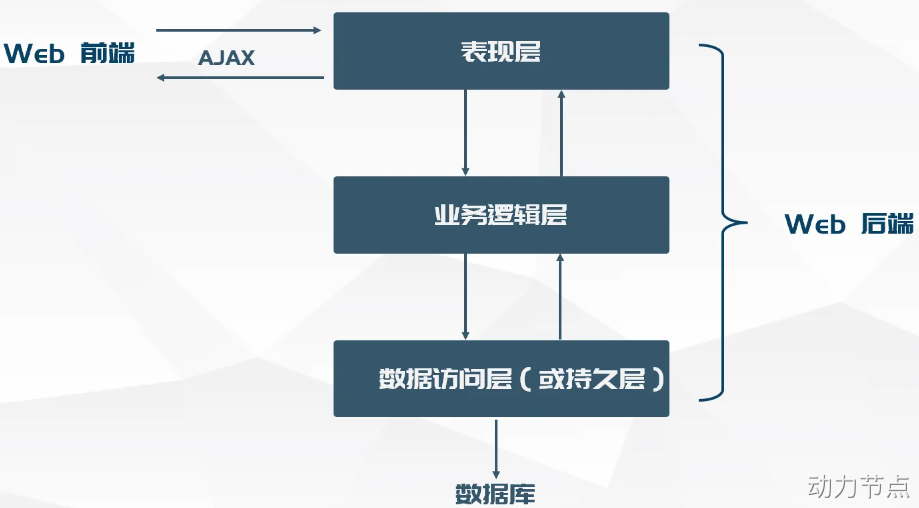
模块名:spring6-013-tx-bank(依赖如下)
pom.xml
<?xml version="1.0" encoding="UTF-8"?>
<project xmlns="http://maven.apache.org/POM/4.0.0"
xmlns:xsi="http://www.w3.org/2001/XMLSchema-instance"
xsi:schemaLocation="http://maven.apache.org/POM/4.0.0 http://maven.apache.org/xsd/maven-4.0.0.xsd">
<modelVersion>4.0.0</modelVersion>
<groupId>com.powernode</groupId>
<artifactId>spring6-013-tx-bank</artifactId>
<version>1.0-SNAPSHOT</version>
<packaging>jar</packaging>
<!--仓库-->
<repositories>
<!--spring里程碑版本的仓库-->
<repository>
<id>repository.spring.milestone</id>
<name>Spring Milestone Repository</name>
<url>https://repo.spring.io/milestone</url>
</repository>
</repositories>
<!--依赖-->
<dependencies>
<!--spring context-->
<dependency>
<groupId>org.springframework</groupId>
<artifactId>spring-context</artifactId>
<version>6.0.0-M2</version>
</dependency>
<!--spring jdbc-->
<dependency>
<groupId>org.springframework</groupId>
<artifactId>spring-jdbc</artifactId>
<version>6.0.0-M2</version>
</dependency>
<!--mysql驱动-->
<dependency>
<groupId>mysql</groupId>
<artifactId>mysql-connector-java</artifactId>
<version>8.0.30</version>
</dependency>
<!--德鲁伊连接池-->
<dependency>
<groupId>com.alibaba</groupId>
<artifactId>druid</artifactId>
<version>1.2.13</version>
</dependency>
<!--@Resource注解-->
<dependency>
<groupId>jakarta.annotation</groupId>
<artifactId>jakarta.annotation-api</artifactId>
<version>2.1.1</version>
</dependency>
<!--junit-->
<dependency>
<groupId>junit</groupId>
<artifactId>junit</artifactId>
<version>4.13.2</version>
<scope>test</scope>
</dependency>
</dependencies>
<properties>
<maven.compiler.source>17</maven.compiler.source>
<maven.compiler.target>17</maven.compiler.target>
</properties>
</project>
第一步:准备数据库表
表结构:

表数据:
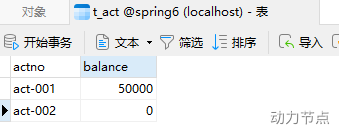
第二步:创建包结构
com.powernode.bank.pojo
com.powernode.bank.service
com.powernode.bank.service.impl
com.powernode.bank.dao
com.powernode.bank.dao.impl
第三步:准备POJO类
package com.powernode.bank.pojo;
/**
* @author 动力节点
* @version 1.0
* @className Account
* @since 1.0
**/
public class Account {
private String actno;
private Double balance;
@Override
public String toString() {
return "Account{" +
"actno='" + actno + '\'' +
", balance=" + balance +
'}';
}
public Account() {
}
public Account(String actno, Double balance) {
this.actno = actno;
this.balance = balance;
}
public String getActno() {
return actno;
}
public void setActno(String actno) {
this.actno = actno;
}
public Double getBalance() {
return balance;
}
public void setBalance(Double balance) {
this.balance = balance;
}
}
第四步:编写持久层
package com.powernode.bank.dao;
import com.powernode.bank.pojo.Account;
/**
* @author 动力节点
* @version 1.0
* @className AccountDao
* @since 1.0
**/
public interface AccountDao {
/**
* 根据账号查询余额
* @param actno
* @return
*/
Account selectByActno(String actno);
/**
* 更新账户
* @param act
* @return
*/
int update(Account act);
}
package com.powernode.bank.dao.impl;
import com.powernode.bank.dao.AccountDao;
import com.powernode.bank.pojo.Account;
import jakarta.annotation.Resource;
import org.springframework.jdbc.core.BeanPropertyRowMapper;
import org.springframework.jdbc.core.JdbcTemplate;
import org.springframework.stereotype.Component;
/**
* @author 动力节点
* @version 1.0
* @className AccountDaoImpl
* @since 1.0
**/
@Repository("accountDao")
public class AccountDaoImpl implements AccountDao {
@Resource(name = "jdbcTemplate")
private JdbcTemplate jdbcTemplate;
@Override
public Account selectByActno(String actno) {
String sql = "select actno, balance from t_act where actno = ?";
Account account = jdbcTemplate.queryForObject(sql, new BeanPropertyRowMapper<>(Account.class), actno);
return account;
}
@Override
public int update(Account act) {
String sql = "update t_act set balance = ? where actno = ?";
int count = jdbcTemplate.update(sql, act.getBalance(), act.getActno());
return count;
}
}
第五步:编写业务层
package com.powernode.bank.service;
/**
* @author 动力节点
* @version 1.0
* @className AccountService
* @since 1.0
**/
public interface AccountService {
/**
* 转账
* @param fromActno
* @param toActno
* @param money
*/
void transfer(String fromActno, String toActno, double money);
}
package com.powernode.bank.service.impl;
import com.powernode.bank.dao.AccountDao;
import com.powernode.bank.pojo.Account;
import com.powernode.bank.service.AccountService;
import jakarta.annotation.Resource;
import org.springframework.stereotype.Service;
/**
* @author 动力节点
* @version 1.0
* @className AccountServiceImpl
* @since 1.0
**/
@Service("accountService")
public class AccountServiceImpl implements AccountService {
@Resource(name = "accountDao")
private AccountDao accountDao;
@Override
public void transfer(String fromActno, String toActno, double money) {
// 查询账户余额是否充足
Account fromAct = accountDao.selectByActno(fromActno);
if (fromAct.getBalance() < money) {
throw new RuntimeException("账户余额不足");
}
// 余额充足,开始转账
Account toAct = accountDao.selectByActno(toActno);
fromAct.setBalance(fromAct.getBalance() - money);
toAct.setBalance(toAct.getBalance() + money);
int count = accountDao.update(fromAct);
count += accountDao.update(toAct);
if (count != 2) {
throw new RuntimeException("转账失败,请联系银行");
}
}
}
第六步:编写Spring配置文件
<?xml version="1.0" encoding="UTF-8"?>
<beans xmlns="http://www.springframework.org/schema/beans"
xmlns:xsi="http://www.w3.org/2001/XMLSchema-instance"
xmlns:context="http://www.springframework.org/schema/context"
xsi:schemaLocation="http://www.springframework.org/schema/beans http://www.springframework.org/schema/beans/spring-beans.xsd
http://www.springframework.org/schema/context http://www.springframework.org/schema/context/spring-context.xsd">
<context:component-scan base-package="com.powernode.bank"/>
<bean id="dataSource" class="com.alibaba.druid.pool.DruidDataSource">
<property name="driverClassName" value="com.mysql.cj.jdbc.Driver"/>
<property name="url" value="jdbc:mysql://localhost:3306/spring6"/>
<property name="username" value="root"/>
<property name="password" value="root"/>
</bean>
<bean id="jdbcTemplate" class="org.springframework.jdbc.core.JdbcTemplate">
<property name="dataSource" ref="dataSource"/>
</bean>
</beans>
第七步:编写表示层(测试程序)
package com.powernode.spring6.test;
import com.powernode.bank.service.AccountService;
import org.junit.Test;
import org.springframework.context.ApplicationContext;
import org.springframework.context.support.ClassPathXmlApplicationContext;
/**
* @author 动力节点
* @version 1.0
* @className BankTest
* @since 1.0
**/
public class BankTest {
@Test
public void testTransfer(){
ApplicationContext applicationContext = new ClassPathXmlApplicationContext("spring.xml");
AccountService accountService = applicationContext.getBean("accountService", AccountService.class);
try {
accountService.transfer("act-001", "act-002", 10000);
System.out.println("转账成功");
} catch (Exception e) {
e.printStackTrace();
}
}
}
执行结果:

数据变化:
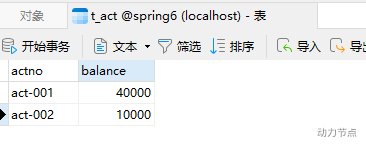
第八步:模拟异常
package com.powernode.bank.service.impl;
import com.powernode.bank.dao.AccountDao;
import com.powernode.bank.pojo.Account;
import com.powernode.bank.service.AccountService;
import jakarta.annotation.Resource;
import org.springframework.stereotype.Service;
/**
* @author 动力节点
* @version 1.0
* @className AccountServiceImpl
* @since 1.0
**/
@Service("accountService")
public class AccountServiceImpl implements AccountService {
@Resource(name = "accountDao")
private AccountDao accountDao;
@Override
public void transfer(String fromActno, String toActno, double money) {
// 查询账户余额是否充足
Account fromAct = accountDao.selectByActno(fromActno);
if (fromAct.getBalance() < money) {
throw new RuntimeException("账户余额不足");
}
// 余额充足,开始转账
Account toAct = accountDao.selectByActno(toActno);
fromAct.setBalance(fromAct.getBalance() - money);
toAct.setBalance(toAct.getBalance() + money);
int count = accountDao.update(fromAct);
// 模拟异常
String s = null;
s.toString();
count += accountDao.update(toAct);
if (count != 2) {
throw new RuntimeException("转账失败,请联系银行");
}
}
}
执行结果:

数据库表中数据:
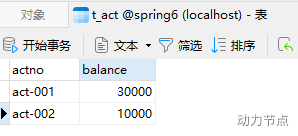
丢了1万!
补充:以上情况很显然在实际业务中是不被允许的Bug。实际开发中一般在一个接口中进行了多行或多表等数据进行插入修改等操作时,就要考虑到对程序事务的处理。使得发生一条或多条数据的操作过程中程序报错,已修改的数据要能够回滚到原先数据状态。
四、Spring对事务的支持
① Spring实现事务的两种方式
-
编程式事务
-
- 通过编写代码的方式来实现事务的管理。(实际项目中我们一般不自己去编写代码实现事务,一般不用。)
-
声明式事务
-
- 基于注解方式(常用)
- 基于
XML配置方式
② Spring事务管理API
Spring对事务的管理底层实现方式是基于AOP实现的。采用AOP的方式进行了封装。所以Spring专门针对事务开发了一套API,API的核心接口如下:
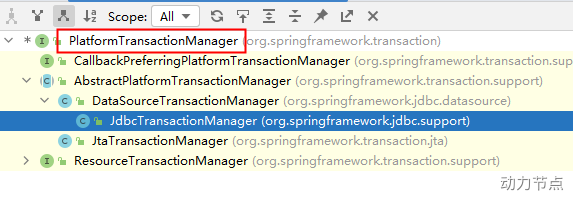
PlatformTransactionManager接口:spring事务管理器的核心接口。在Spring6中它有两个实现:
DataSourceTransactionManager:支持JdbcTemplate、MyBatis、Hibernate等事务管理。JtaTransactionManager:支持分布式事务管理。
如果要在Spring6中使用JdbcTemplate,就要使用DataSourceTransactionManager来管理事务。(Spring内置写好了,可以直接用。)
③ 声明式事务之注解实现方式
- 第一步:在
spring配置文件中配置事务管理器。
<bean id="transactionManager" class="org.springframework.jdbc.datasource.DataSourceTransactionManager">
<property name="dataSource" ref="dataSource"/>
</bean>
- 第二步:在
spring配置文件中引入tx命名空间。
<?xml version="1.0" encoding="UTF-8"?>
<beans xmlns="http://www.springframework.org/schema/beans"
xmlns:xsi="http://www.w3.org/2001/XMLSchema-instance"
xmlns:context="http://www.springframework.org/schema/context"
xmlns:tx="http://www.springframework.org/schema/tx"
xsi:schemaLocation="http://www.springframework.org/schema/beans http://www.springframework.org/schema/beans/spring-beans.xsd
http://www.springframework.org/schema/context http://www.springframework.org/schema/context/spring-context.xsd
http://www.springframework.org/schema/tx http://www.springframework.org/schema/tx/spring-tx.xsd">
- 第三步:在
spring配置文件中配置“事务注解驱动器”,开始注解的方式控制事务。
<tx:annotation-driven transaction-manager="transactionManager"/>
- 第四步:在
service类上或方法上添加@Transactional注解
在类上添加该注解,该类中所有的方法都有事务。在某个方法上添加该注解,表示只有这个方法使用事务。
补充:实际开发中一般不直接在类上添加@Transactional注解,根据接口对数据库操作需求来决定是否在接口上添加该注解。像大部分只进行查询操作的接口,是没有必要开启事务的。只要开启必定会影响接口代码执行速度。
package com.powernode.bank.service.impl;
import com.powernode.bank.dao.AccountDao;
import com.powernode.bank.pojo.Account;
import com.powernode.bank.service.AccountService;
import jakarta.annotation.Resource;
import org.springframework.stereotype.Service;
import org.springframework.transaction.annotation.Transactional;
/**
* @author 动力节点
* @version 1.0
* @className AccountServiceImpl
* @since 1.0
**/
@Service("accountService")
@Transactional
public class AccountServiceImpl implements AccountService {
@Resource(name = "accountDao")
private AccountDao accountDao;
@Override
public void transfer(String fromActno, String toActno, double money) {
// 查询账户余额是否充足
Account fromAct = accountDao.selectByActno(fromActno);
if (fromAct.getBalance() < money) {
throw new RuntimeException("账户余额不足");
}
// 余额充足,开始转账
Account toAct = accountDao.selectByActno(toActno);
fromAct.setBalance(fromAct.getBalance() - money);
toAct.setBalance(toAct.getBalance() + money);
int count = accountDao.update(fromAct);
// 模拟异常
String s = null;
s.toString();
count += accountDao.update(toAct);
if (count != 2) {
throw new RuntimeException("转账失败,请联系银行");
}
}
}
当前数据库表中的数据:
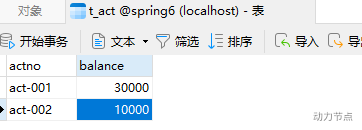
执行测试程序:

虽然出现异常了,再次查看数据库表中数据:

通过测试,发现数据没有变化,事务起作用了。
五、事务属性
即:@Transactional注解中有哪些属性可以配置,分别有什么作用。
① 事务属性包括哪些
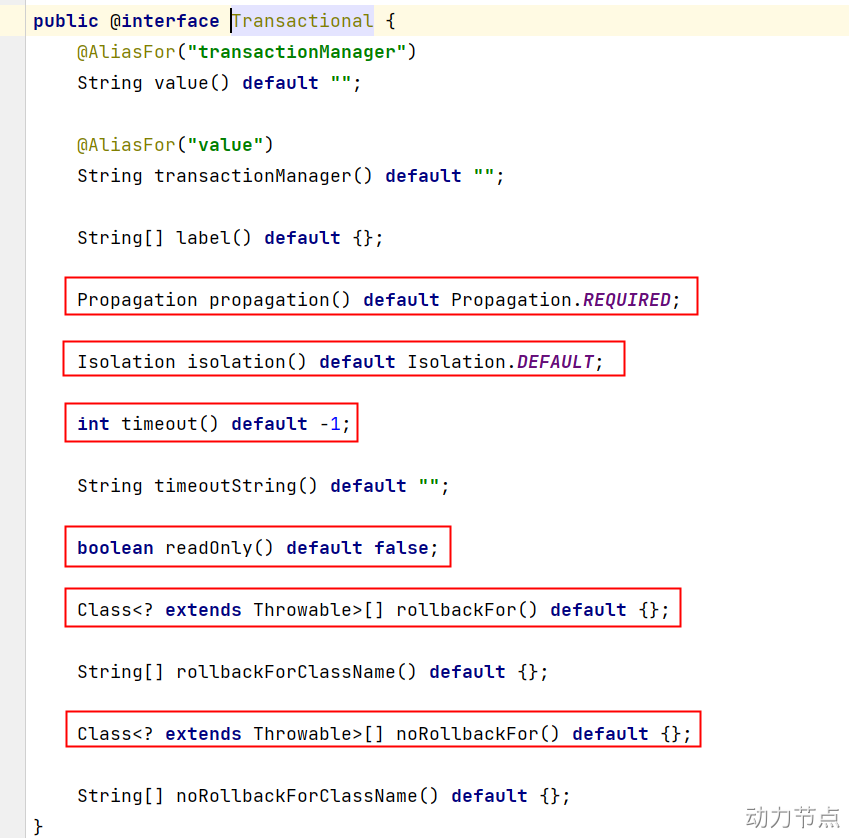
事务中的重点属性:
- 事务传播行为
- 事务隔离级别
- 事务超时
- 只读事务
- 设置出现哪些异常回滚事务
- 设置出现哪些异常不回滚事务
② 事务传播行为
什么是事务的传播行为?
在service类中有a()方法和b()方法,a()方法上有事务,b()方法上也有事务,当a()方法执行过程中调用了b()方法,事务是如何传递的?合并到一个事务里?还是开启一个新的事务?这就是事务传播行为。
事务传播行为在spring框架中被定义为枚举类型:
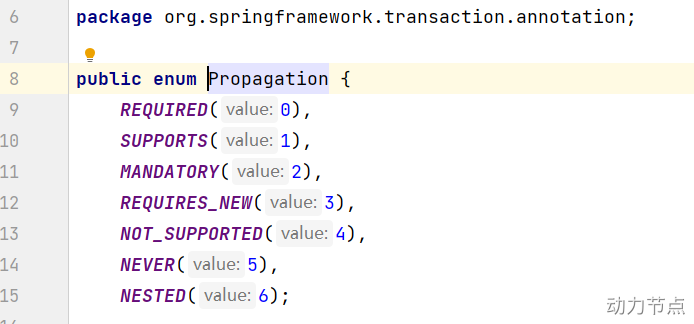
一共有七种传播行为:
REQUIRED:支持当前事务,如果不存在就新建一个(默认)【没有就新建,有就加入】SUPPORTS:支持当前事务,如果当前没有事务,就以非事务方式执行【有就加入,没有就不管了】MANDATORY:必须运行在一个事务中,如果当前没有事务正在发生,将抛出一个异常【有就加入,没有就抛异常】REQUIRES_NEW:开启一个新的事务,如果一个事务已经存在,则将这个存在的事务挂起【不管有没有,直接开启一个新事务,开启的新事务和之前的事务不存在嵌套关系,之前事务被挂起】NOT_SUPPORTED:以非事务方式运行,如果有事务存在,挂起当前事务【不支持事务,存在就挂起】NEVER:以非事务方式运行,如果有事务存在,抛出异常【不支持事务,存在就抛异常】NESTED:如果当前正有一个事务在进行中,则该方法应当运行在一个嵌套式事务中。被嵌套的事务可以独立于外层事务进行提交或回滚。如果外层事务不存在,行为就像REQUIRED一样。【有事务的话,就在这个事务里再嵌套一个完全独立的事务,嵌套的事务可以独立的提交和回滚。没有事务就和REQUIRED一样。】
在代码中设置事务的传播行为:
@Transactional(propagation = Propagation.REQUIRED)
可以编写程序测试一下传播行为:
@Transactional(propagation = Propagation.REQUIRED)
public void save(Account act) {
// 这里调用dao的insert方法。
accountDao.insert(act); // 保存act-003账户
// 创建账户对象
Account act2 = new Account("act-004", 1000.0);
try {
accountService.save(act2); // 保存act-004账户
} catch (Exception e) {
}
// 继续往后进行我当前1号事务自己的事儿。
}
1号service
@Transactional(propagation = Propagation.REQUIRED)
public void save(Account act) {
// 这里调用dao的insert方法。
accountDao.insert(act); // 保存act-003账户
// 创建账户对象
Account act2 = new Account("act-004", 1000.0);
try {
accountService.save(act2); // 保存act-004账户
} catch (Exception e) {
}
// 继续往后进行我当前1号事务自己的事儿。
}
2号service
@Override
//@Transactional(propagation = Propagation.REQUIRED)
@Transactional(propagation = Propagation.REQUIRES_NEW)
public void save(Account act) {
accountDao.insert(act);
// 模拟异常
String s = null;
s.toString();
// 事儿没有处理完,这个大括号当中的后续也许还有其他的DML语句。
}
一定要集成Log4j2日志框架,在日志信息中可以看到更加详细的信息。
③ 事务的传播行为补充解读
我想,你看完上述笔记,如果不听老杜的视频课程,可能还是懵懵的状态。所以我就以我个人的理解再对上述笔记进行一下补充解读。
从上述笔记中我们知道什么是事务的传播行为这一名词,我这里在复述一下。所谓事务的传播行为就是,当两个接口方法都包含@Transactional注解,且其中一个接口方法内部调用了另一个包含@Transactional注解的接口方法,那么代码执行过程中是开启一个事务、还是多个、还是挂起其中一个等情况,就是所谓的事务传播行为。综上,我们再理解一下七种事务的传播行为。
当方法a中调用了方法b,且两者都包含@Transactional注解,且传播行为均使用默认值REQUIRED。当a方法被执行时,由于在此之前没有开启过事务,所以第一次遇到@Transactional注解则开启一个事务A,当执行到被调用方法b时第二次遇到@Transactional注解,且传播行为为REQUIRED。同时因为此刻已经开启了事务A,所以方法b直接加入到事务A管理,不会再创建新事务(这就是所谓的【没有就新建,有就加入】)。因此不管在方法a中出现异常还是b中出现异常,事务A均会整体回滚。
我们再来理解一个REQUIRES_NEW传播行为(【不管有没有,直接开启一个新事务,开启的新事务和之前的事务不存在嵌套关系,之前事务被挂起】)。当方法a中调用了方法b,且两者都包含@Transactional注解,且a方法传播行为使用默认值REQUIRED,b方法传播行为使用REQUIRES_NEW。当a方法被执行时,由于在此之前没有开启过事务,所以第一次遇到@Transactional注解则开启一个事务A,当执行到被调用方法b时第二次遇到@Transactional注解,且传播行为为REQUIRES_NEW。该行为不管该方法是否处在事务A当中,都会新建一个事务(事务B),且两个事务不存在嵌套关系。在事务B的代码执行时,事务A处于挂起状态,等待事务B提交后继续执行事务A的后续代码。如果在执行方法b的过程中出现了异常,方法b中的数据库操作正常回滚,同时异常会传递给方法a调用方法b的位置,方法a所在的事务A也会进行回滚。如果在方法a调用方法b的位置进行了异常的捕获处理,则方法a会继续正常执行,事务A中是不会进行回滚的。
通过以上两个事务传播行为理解刨析,你也可以尝试去理解另外五种事务传播行为。
④ 事务隔离级别
事务隔离级别类似于教室A和教室B之间的那道墙,隔离级别越高表示墙体越厚。隔音效果越好。
数据库中读取数据存在的三大问题:(三大读问题)
● 脏读:读取到没有提交到数据库的数据,叫做脏读。
● 不可重复读:在同一个事务当中,第一次和第二次读取的数据不一样。
● 幻读:读到的数据是假的。
事务隔离级别包括四个级别:
● 读未提交:READ_UNCOMMITTED
○ 这种隔离级别,存在脏读问题,所谓的脏读(dirty read)表示能够读取到其它事务未提交的数据。(事务A和事务B同时进行,事务B插入数据但未提交,事务A却能读到,这就是脏读问题)
● 读提交:READ_COMMITTED
○ 解决了脏读问题,其它事务提交之后才能读到,但存在不可重复读问题。(事务A和事务B同时进行,事务B插入数据已提交,假设事务A的程序在事务B未提交时读到3条数据,事务B提交10条数据之后,事务A的程序未提交同时又读了一次数据却读到了13条数据,同一个程序中两次读到的数据不一样,这就是不可重复读问题)
● 可重复读:REPEATABLE_READ
○ 解决了不可重复读,可以达到可重复读效果,只要当前事务不结束,读取到的数据一直都是一样的。但存在幻读问题。(这种隔离基本解决了不可重复读问题,即事务A多次读取,不管事务B是否在这期间插入或者删除了数据,均使用事务A第一次读到的数据。但是仍然存在幻读问题,即事务A和事务B同时对一条数据进行修改操作,假设A打算将数据从C改为A,然后B打算将数据从C改为B,由于事务A先进行的更改,所以事务A再去查询自己该的数据,发现数据既然变成了B,而不是自己想要的A,事务B查询到的确是自己想要的数据,这种由多事务交叉并发导致预期结果和实际不同的现象,就是幻读问题)
● 序列化:SERIALIZABLE
○ 解决了幻读问题,事务排队执行。不支持并发。(这种隔离级别解决了幻读问题,在这种级别下,必须将事务B必须要等事务A提交之后才能执行。即事务A执行完修改和查询等操作提交事务之后,事务B才能进行修改和查询操作。)
大家可以通过一个表格来记忆:
| 隔离级别 | 脏读 | 不可重复读 | 幻读 |
|---|---|---|---|
| 读未提交 | 有 | 有 | 有 |
| 读提交 | 无 | 有 | 有 |
| 可重复读 | 无 | 无 | 有 |
| 序列化 | 无 | 无 | 无 |
在Spring代码中如何设置隔离级别?
隔离级别在spring中以枚举类型存在:
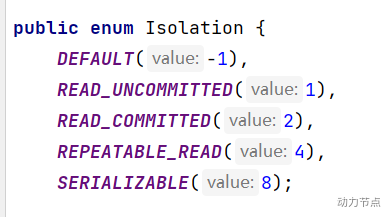
使用数据库默认的隔离级别:
@Transactional(isolation = Isolation.DEFAULT)
知识点补充:Oracle数据库的默认隔离级别是读已提交(READ_COMMITTED),Mysql数据库的默认隔离级别是可重复读(REPEATABLE_READ)。
测试事务隔离级别:READ_UNCOMMITTED 和 READ_COMMITTED
怎么测试:一个service负责插入,一个service负责查询。负责插入的service要模拟延迟。
IsolationService1
package com.powernode.bank.service.impl;
import com.powernode.bank.dao.AccountDao;
import com.powernode.bank.pojo.Account;
import jakarta.annotation.Resource;
import org.springframework.stereotype.Service;
import org.springframework.transaction.annotation.Isolation;
import org.springframework.transaction.annotation.Transactional;
/**
* @author 动力节点
* @version 1.0
* @className IsolationService1
* @since 1.0
**/
@Service("i1")
public class IsolationService1 {
@Resource(name = "accountDao")
private AccountDao accountDao;
// 1号
// 负责查询
// 当前事务可以读取到别的事务没有提交的数据。
//@Transactional(isolation = Isolation.READ_UNCOMMITTED)
// 对方事务提交之后的数据我才能读取到。
@Transactional(isolation = Isolation.READ_COMMITTED)
public void getByActno(String actno) {
Account account = accountDao.selectByActno(actno);
System.out.println("查询到的账户信息:" + account);
}
}
IsolationService2
package com.powernode.bank.service.impl;
import com.powernode.bank.dao.AccountDao;
import com.powernode.bank.pojo.Account;
import jakarta.annotation.Resource;
import org.springframework.stereotype.Service;
import org.springframework.transaction.annotation.Transactional;
/**
* @author 动力节点
* @version 1.0
* @className IsolationService2
* @since 1.0
**/
@Service("i2")
public class IsolationService2 {
@Resource(name = "accountDao")
private AccountDao accountDao;
// 2号
// 负责insert
@Transactional
public void save(Account act) {
accountDao.insert(act);
// 睡眠一会
try {
Thread.sleep(1000 * 20);
} catch (InterruptedException e) {
e.printStackTrace();
}
}
}
测试程序:
@Test
public void testIsolation1(){
ApplicationContext applicationContext = new ClassPathXmlApplicationContext("spring.xml");
IsolationService1 i1 = applicationContext.getBean("i1", IsolationService1.class);
i1.getByActno("act-004");
}
@Test
public void testIsolation2(){
ApplicationContext applicationContext = new ClassPathXmlApplicationContext("spring.xml");
IsolationService2 i2 = applicationContext.getBean("i2", IsolationService2.class);
Account act = new Account("act-004", 1000.0);
i2.save(act);
}
通过执行结果可以清晰的看出隔离级别不同,执行效果不同。
⑤ 事务超时
代码如下:
@Transactional(timeout = 10)
以上代码表示设置事务的超时时间为10秒。
表示超过10秒如果该事务中所有的DML语句还没有执行完毕的话,最终结果会选择回滚。
默认值-1,表示没有时间限制。
这里有个坑,事务的超时时间指的是哪段时间?
在当前事务当中,最后一条DML语句执行之前的时间。如果最后一条DML语句后面很有很多业务逻辑,这些业务代码执行的时间不被计入超时时间。
以下代码的超时不会被计入超时时间:
@Transactional(timeout = 10) // 设置事务超时时间为10秒。
public void save(Account act) {
accountDao.insert(act);
// 睡眠一会
try {
Thread.sleep(1000 * 15);
} catch (InterruptedException e) {
e.printStackTrace();
}
}
以下代码超时时间会被计入超时时间:
@Transactional(timeout = 10) // 设置事务超时时间为10秒。
public void save(Account act) {
// 睡眠一会
try {
Thread.sleep(1000 * 15);
} catch (InterruptedException e) {
e.printStackTrace();
}
accountDao.insert(act);
}
当然,如果想让整个方法的所有代码都计入超时时间的话,可以在方法最后一行添加一行无关紧要的DML语句。
⑥ 只读事务
@Transactional(readOnly = true)
将当前事务设置为只读事务,在该事务执行过程中只允许select语句执行,delete、insert、update均不可执行。
该特性的作用是:启动spring的优化策略。提高select语句执行效率。
如果该事务中确实没有增删改操作,建议设置为只读事务。
⑦ 设置哪些异常回滚事务
代码如下:
@Transactional(noRollbackFor = NullPointerException.class)
表示只有发生RuntimeException异常或该异常的子类异常才回滚。
⑧ 设置哪些异常不回滚事务
代码如下:
@Transactional(noRollbackFor = NullPointerException.class)
表示发生NullPointerException或该异常的子类异常不回滚,其他异常则回滚。
六、事务的全注解式开发
编写一个类来代替配置文件,代码如下:
package com.powernode.bank;
import com.alibaba.druid.pool.DruidDataSource;
import org.springframework.context.annotation.Bean;
import org.springframework.context.annotation.ComponentScan;
import org.springframework.context.annotation.Configuration;
import org.springframework.jdbc.core.JdbcTemplate;
import org.springframework.jdbc.datasource.DataSourceTransactionManager;
import org.springframework.transaction.annotation.EnableTransactionManagement;
import javax.sql.DataSource;
/**
* @author 动力节点
* @version 1.0
* @className Spring6Config
* @since 1.0
**/
@Configuration
@ComponentScan("com.powernode.bank")
@EnableTransactionManagement
public class Spring6Config {
@Bean
public DataSource getDataSource(){
DruidDataSource dataSource = new DruidDataSource();
dataSource.setDriverClassName("com.mysql.cj.jdbc.Driver");
dataSource.setUrl("jdbc:mysql://localhost:3306/spring6");
dataSource.setUsername("root");
dataSource.setPassword("root");
return dataSource;
}
@Bean(name = "jdbcTemplate")
public JdbcTemplate getJdbcTemplate(DataSource dataSource){
JdbcTemplate jdbcTemplate = new JdbcTemplate();
jdbcTemplate.setDataSource(dataSource);
return jdbcTemplate;
}
@Bean
public DataSourceTransactionManager getDataSourceTransactionManager(DataSource dataSource){
DataSourceTransactionManager dataSourceTransactionManager = new DataSourceTransactionManager();
dataSourceTransactionManager.setDataSource(dataSource);
return dataSourceTransactionManager;
}
}
测试程序如下:
@Test
public void testNoXml(){
ApplicationContext applicationContext = new AnnotationConfigApplicationContext(Spring6Config.class);
AccountService accountService = applicationContext.getBean("accountService", AccountService.class);
try {
accountService.transfer("act-001", "act-002", 10000);
System.out.println("转账成功");
} catch (Exception e) {
e.printStackTrace();
}
}
执行结果:

数据库表中数据:
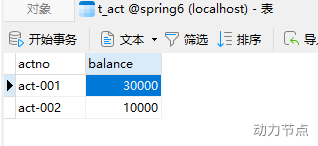
七、声明式事务之XML实现方式
配置步骤:
- 第一步:配置事务管理器
- 第二步:配置通知
- 第三步:配置切面
记得添加aspectj的依赖:
<!--aspectj依赖-->
<dependency>
<groupId>org.springframework</groupId>
<artifactId>spring-aspects</artifactId>
<version>6.0.0-M2</version>
</dependency>
Spring配置文件如下:
记得添加aop的命名空间。
<?xml version="1.0" encoding="UTF-8"?>
<beans xmlns="http://www.springframework.org/schema/beans"
xmlns:xsi="http://www.w3.org/2001/XMLSchema-instance"
xmlns:context="http://www.springframework.org/schema/context"
xmlns:tx="http://www.springframework.org/schema/tx"
xmlns:aop="http://www.springframework.org/schema/aop"
xsi:schemaLocation="http://www.springframework.org/schema/beans http://www.springframework.org/schema/beans/spring-beans.xsd
http://www.springframework.org/schema/context http://www.springframework.org/schema/context/spring-context.xsd
http://www.springframework.org/schema/tx http://www.springframework.org/schema/tx/spring-tx.xsd
http://www.springframework.org/schema/aop http://www.springframework.org/schema/aop/spring-aop.xsd">
<context:component-scan base-package="com.powernode.bank"/>
<bean id="dataSource" class="com.alibaba.druid.pool.DruidDataSource">
<property name="driverClassName" value="com.mysql.cj.jdbc.Driver"/>
<property name="url" value="jdbc:mysql://localhost:3306/spring6"/>
<property name="username" value="root"/>
<property name="password" value="root"/>
</bean>
<bean id="jdbcTemplate" class="org.springframework.jdbc.core.JdbcTemplate">
<property name="dataSource" ref="dataSource"/>
</bean>
<!--配置事务管理器-->
<bean id="transactionManager" class="org.springframework.jdbc.datasource.DataSourceTransactionManager">
<property name="dataSource" ref="dataSource"/>
</bean>
<!--配置通知-->
<tx:advice id="txAdvice" transaction-manager="txManager">
<tx:attributes>
<tx:method name="save*" propagation="REQUIRED" rollback-for="java.lang.Throwable"/>
<tx:method name="del*" propagation="REQUIRED" rollback-for="java.lang.Throwable"/>
<tx:method name="update*" propagation="REQUIRED" rollback-for="java.lang.Throwable"/>
<tx:method name="transfer*" propagation="REQUIRED" rollback-for="java.lang.Throwable"/>
</tx:attributes>
</tx:advice>
<!--配置切面-->
<aop:config>
<aop:pointcut id="txPointcut" expression="execution(* com.powernode.bank.service..*(..))"/>
<!--切面 = 通知 + 切点-->
<aop:advisor advice-ref="txAdvice" pointcut-ref="txPointcut"/>
</aop:config>
</beans>
将AccountServiceImpl类上的@Transactional注解删除。
编写测试程序:
@Test
public void testTransferXml(){
ApplicationContext applicationContext = new ClassPathXmlApplicationContext("spring2.xml");
AccountService accountService = applicationContext.getBean("accountService", AccountService.class);
try {
accountService.transfer("act-001", "act-002", 10000);
System.out.println("转账成功");
} catch (Exception e) {
e.printStackTrace();
}
}
执行结果:

数据库表中记录:
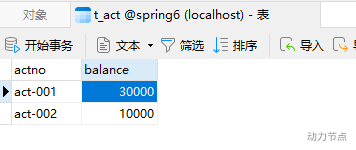
通过测试可以看到配置XML已经起作用了。
八、总结
事务这部分是开发中比较重要的知识,需要重点掌握。
这里需要去了解老杜这节相关讲解,可以直接点击下面链接跳转到对应课程学习了解!

